|
Early Days
@It is believed that the Japanese archipelago became separated from the mainland of Asia about 20,000 years ago, at the end of the last Ice Age. Therefore, the inhabitants of Japan are of basically the same ethnic origin as the nearby Asian peoples, perhaps mixed to some extent with seafaring migrants from Polynesia.
Over a period of some 8,000 years a distinctive form of civilization evolved of which the surviving features are shell mounds (kaizuka iseki) and a form of pottery bearing patterns made with ropes. This is known as Jomon earthenware and, because of its distinctiveness, this period of Japanese history is usually referred to as the Jomon Era. The people of this time were hunters and fishers who also gathered wild fruits and vegetables. The period covering the  third century B.C. to the second century A.D. is known as the Yayoi Era. Yayoi is a place in the Tokyo area where pottery dating from this period was discovered. At this time, people started to live on farms and to cultivate crops, adopting from the Asian continent the system of paddy-farming to produce rice. Metal implements started to be used and the population began to gather into local communities, leading to the development of a system of village leaders and priests. Gradually provinces started to be formed with their own leaders. Kofun or Yamato Era (From end of 3rd century B.C. until 7th century A.D. ) Yamato is the name of a place near the present Nara. Yamato became central in the process of unification of the nation, which first occurred during this period, albeit on a rather loose and informal basis. The history books claim that the first Emperor of Japan was Jimmu, who was enthroned on 11th February in the year 660 B.C. 11th February is still a third century B.C. to the second century A.D. is known as the Yayoi Era. Yayoi is a place in the Tokyo area where pottery dating from this period was discovered. At this time, people started to live on farms and to cultivate crops, adopting from the Asian continent the system of paddy-farming to produce rice. Metal implements started to be used and the population began to gather into local communities, leading to the development of a system of village leaders and priests. Gradually provinces started to be formed with their own leaders. Kofun or Yamato Era (From end of 3rd century B.C. until 7th century A.D. ) Yamato is the name of a place near the present Nara. Yamato became central in the process of unification of the nation, which first occurred during this period, albeit on a rather loose and informal basis. The history books claim that the first Emperor of Japan was Jimmu, who was enthroned on 11th February in the year 660 B.C. 11th February is still a 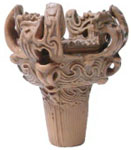 national holiday to commemorate the founding of the nation. In fact, however, there is little reason to suppose that there is any accuracy in the date chosen or the year given. Modern thought is that they simply happened to fit with a cycle of auspicious events according to the Chinese calendar. It was during the Yamato Era that the Emperor of Japan really started to be recognized as a figurehead. He gradually gained in power as the unification proceeded and at this time the title of Emperor was first used. Various burial mounds (kofun) attest to the power and wealth which the Imperial family gradually gained. Accordingly, archaeologists sometimes refer to this period as the Kofun Era, while the word Yamato is still used to this day to describe Something which is distinctively Japanese. For example, a picture in a uniquely Japanese style is referred to as yamato-e, a Japanese spirit as yamato damashii and a Japanese lady as yamato nadeshiko. national holiday to commemorate the founding of the nation. In fact, however, there is little reason to suppose that there is any accuracy in the date chosen or the year given. Modern thought is that they simply happened to fit with a cycle of auspicious events according to the Chinese calendar. It was during the Yamato Era that the Emperor of Japan really started to be recognized as a figurehead. He gradually gained in power as the unification proceeded and at this time the title of Emperor was first used. Various burial mounds (kofun) attest to the power and wealth which the Imperial family gradually gained. Accordingly, archaeologists sometimes refer to this period as the Kofun Era, while the word Yamato is still used to this day to describe Something which is distinctively Japanese. For example, a picture in a uniquely Japanese style is referred to as yamato-e, a Japanese spirit as yamato damashii and a Japanese lady as yamato nadeshiko.
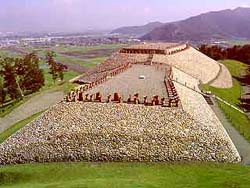
Kofun Written by T.Kusunoki
From (introductory part of book) "Japan"
Published by Borgnan Corporation
Copyright(C)2004-2005 Borgnan Co.,Ltd. All Rights Reserved. |
Asuka Era (From mid-6th century until early 8th century)
In the year 538, Buddhism was introduced to Japan from China and Prince Shotoku (573- 620) adopted it as the  state religion, building the famous temple named Horyu-ji just outside Nara as a centre for the faith. Prince Shotoku was a particularly capable and enlightened leader who worked hard to establish a strong centralized nation with a single leader. He promulgated the 'Seventeen Articles' defining, the concept of a nation. He also developed the 'Twelve Ranks' system whereby ordinary people could win promotion to higher positions. He sent students and priests to China to broaden their horizons and to improve diplomatic ties and he was the first person to use the phrase "The Nation of the Rising Sun' to refer to Japan in diplomatic correspondence.
After the death of Prince Shotoku, Prince Nakono Oe carried out reforms in 645 leading
to the further centralization of authority. In 701 all land and servants of the court and nobles
were placed under the control of the central government, following the example of China, and
a taxation system was introduced. For the first time original coinage was minted. 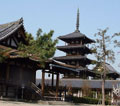
Horyu-ji Written by T.Kusunoki
From (introductory part of book) "Japan"
Published by Borgnan Corporation
Copyright(C)2004-2005 Borgnan Co.,Ltd. All Rights Reserved.
|
Nara Era(710-784)
Until this time, the location of the national capital had changed every time there was a new Emperor. This was because the land of the old capital was thought to be polluted by the death of the former Emperor. However, this was a rather inconvenient system, as can be imagined, so, in 710, it was decided to establish a permanent capital in Nara. Thus Nara remained the capital of Japan until 784.
 Under the guidance of another enlightened leader, the Emperor Shomu, the capital grew steadily and increased in prosperity. Buddhism was promoted and the temple of Todai-ji was constructed with its famous Big Buddha image. Also, all around the country were constructed temples named Kokubun-ji, the word meaning 'nationally-proliferated temples', sponsored by the government. Under the guidance of another enlightened leader, the Emperor Shomu, the capital grew steadily and increased in prosperity. Buddhism was promoted and the temple of Todai-ji was constructed with its famous Big Buddha image. Also, all around the country were constructed temples named Kokubun-ji, the word meaning 'nationally-proliferated temples', sponsored by the government.
However, as the century progressed, the constitutional government system gradually began to collapse and the court nobles once again started to own land and servants privately. These people increased in wealth and power and started to create, their own aristocratic culture.
Written by T.Kusunoki
From (introductory part of book) "Japan"
Published by Borgnan Corporation
Copyright(C)2004-2005 Borgnan Co.,Ltd. All Rights Reserved. |
Heian Era(794-1185)
In order to restructure the system of government, as well as to sever the strong
influential ties between Buddhism and government,the Emperor Kanmu decided to move the
Imperial capital to Kyoto, which remained the seat of Emperors for more than a millennium,
until the beginning of the Meiji Era in 1868. Like Nara, Kyoto was modeled on the system
used in China.
It is at this stage in Japanese history that we find the word shogun first being used. In the
early ninth century, the border of Japan was extended as far north as the tip of the present
nation's main island of Honshu. To do this, it was necessary to push back the Ainu people who
were already living in the northern areas of Honshu. Campaigns were waged and the generals
in charge were given the title of Seii-tai Shogun ('Great Barbarian-Crushing Generalissimo').
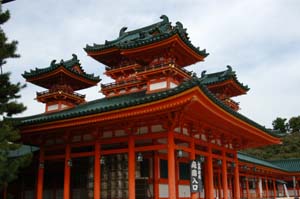
Heian-kyo(in Kyoto)
At the successful conclusion of the campaign,the title would be relinquished and returned to
the Emperor, who would usually grant some favour by way of thanks.
Now, however, the Emperors began to neglect politics and to spend much of their time at leisure 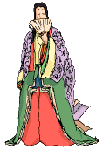 or in pursuit of studies of the arts, literature or culture. Taking advantage of this change in interests, the noble family of Fujiwara began to gain influence by controlling the political scene. The peak of the power of the Fujiwaras came in the eleventh century. They married into the royal family and managed to monopolize almost all of the important government positions. As time went on, or in pursuit of studies of the arts, literature or culture. Taking advantage of this change in interests, the noble family of Fujiwara began to gain influence by controlling the political scene. The peak of the power of the Fujiwaras came in the eleventh century. They married into the royal family and managed to monopolize almost all of the important government positions. As time went on, 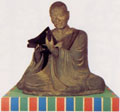 however, the Fujiwara family too became corrupted by luxury and this allowed the rise of the samurai (warrior) class to positions of politicalstrength. however, the Fujiwara family too became corrupted by luxury and this allowed the rise of the samurai (warrior) class to positions of politicalstrength.
The first samurai to come to power were the Taira family, but their supremacy was short-lived, as they were defeated by the Minamoto clan first at the bloody battle of Yashima, near Takamatsu in Shikoku, in 1184, and then, finally, a year later, at the battle of Dan-no-ura, near Shimonoseki at the western tip of Honshu.
In terms of culture, this, period saw Japan loosening her ties with China and developing her own distinctive culture. The system of dispatching regular scholarly and diplomatic missions to China ceased in 894.
Written by T.Kusunoki
From (introductory part of book) "Japan"
Published by Borgnan Corporation
Copyright(C)2004-2005 Borgnan Co.,Ltd. All Rights Reserved.
|
Kamakura Era (1192. - 1333)
Minamoto's victory spelt the end for aristocratic court government with the Emperor as the central figure. Instead, Japan was now to have a military administration. Minamoto Yoritomo persuaded the Emperor to appoint him as shogun, a title which he did not return at the end of any campaign, and he became the first administrative shogun in the country's history. To avoid the bad example of his predecessors in power, he decided to shift his base away from the affluent atmosphere of Kyoto and chose Kamakura, a short distance west of the present Tokyo, for his administrative headquarters (bakufu). For the next 700 years, Japan was to be ruled by the samurai class under a feudal system by which the shogun would divide the land among the local lords (daimyo), in return for which they would pledge absolute allegiance to him.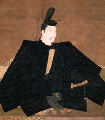
The control of the Minamoto family lasted for three generations, until Minamoto
Sanemoto, the grandson of Yoritomo, was assassinated in Kamakura in 1219 as part of a
family feud. As the result of the plotting of the Hojo family (the family of Yoritomo's wife),
all of the possible Minamoto successors were eliminated and power moved into the hands of
the Hojos,who controlled the Kamakura government for the next 140 years. To do this, they
invited a member of the Fujiwara family to accept the nominal title of shogun and kept the
reigns of actual power firmly within their own circle.
It was at this time that Japan faced its first ever serious threat of invasion. The Mongols,
under Kublai Khan, the descendent of Genghis Khan, the founder of the Mongolian Empire, had already conquered most of central Asia, and had established an empire which stretched from China to eastern Europe, the most extensive that the world had ever seen. Kublai Khan sent a letter to Japan demanding that the country pay tribute to him or risk the threat of Evasion. Japan refused and the Mongols sent a first expeditionary force to Hakata (Fukuoka) in Kyushu in 1274. With the assistance of a typhoon, Japan repelled the troops. However, the threat was not ended, for in 1281 a much large,force was dispatched,an huge army of over100,000 soldiers. Fortunately, a typhoon occurred again at the vital moment and the Mongolian fleet was wrecked, with the assistance of a defensive wall which the Japanese hadbuilt. The typhoon which had been instrumental in the destruction of the Mongolian fleet wasreferred to as a 'Divine Wind' (kamikaze), a term which was resurrected at the end of the Second World War to describe those who were prepared to give their lives in support of their nation and in the hope of divine assistance. Following the kamikaze of 1281, both the troops involved and the priests who claimed that they had prayed for divine intervention awaited their reward from the Kamakura government, but Kamakura had nothing to offer and a feeling of discontent began to spread. The Emperor Godaigo in Kyoto was not slow to notice this change in the political situation and made an attempt to regain real power from these favourable circumstances. At his second attempt, he managed to set up an administration in 1334. For a brief period, imperial power was restored. Fortunately, a typhoon occurred again at the vital moment and the Mongolian fleet was wrecked, with the assistance of a defensive wall which the Japanese hadbuilt. The typhoon which had been instrumental in the destruction of the Mongolian fleet wasreferred to as a 'Divine Wind' (kamikaze), a term which was resurrected at the end of the Second World War to describe those who were prepared to give their lives in support of their nation and in the hope of divine assistance. Following the kamikaze of 1281, both the troops involved and the priests who claimed that they had prayed for divine intervention awaited their reward from the Kamakura government, but Kamakura had nothing to offer and a feeling of discontent began to spread. The Emperor Godaigo in Kyoto was not slow to notice this change in the political situation and made an attempt to regain real power from these favourable circumstances. At his second attempt, he managed to set up an administration in 1334. For a brief period, imperial power was restored. |
Muromachi Era (1338 - 1573)
Unfortunately for him, the Emperor Godaigo respected and rewarded only nobles and priests. Thus the warriors came to bear a grudge against him and the warlord Ashikaga Takauji, 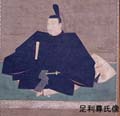
Yet, by the time of the eighth Muromachi shogun, Ashikaga Yoshimasa, the man who built Ginkaku-ji, the shogunate had also lost power and from this time poor administration coupled with excessive taxation was to result in civil chaos.
 A problem regarding the succession to the shogunate led to a major war in 1467 and this was followed by a century of feuding when powerful lords tried to expel or kill their masters in order to grasp higher positions, in total defiance of the bushido code of chivalry, which was based on absolute loyalty to one's master. This period is often referred to as the 'Warring States' period. , * A problem regarding the succession to the shogunate led to a major war in 1467 and this was followed by a century of feuding when powerful lords tried to expel or kill their masters in order to grasp higher positions, in total defiance of the bushido code of chivalry, which was based on absolute loyalty to one's master. This period is often referred to as the 'Warring States' period. , *
Finally, in 1573, a relatively minor warlord, Oda Nobunaga, expelled the fifteenth Muromachi shogun and the Muromachi Era came to an end. Although the political administration had been unstable during the Muromachi Era, culture had flourished and the popularity of Noh, Kyogen, Zen Buddhism, Tea Ceremony and Flower Arrangement, for
example, had increased very considerably especially amongst the nobility.
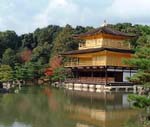
Kinkaku-ji |
Azuchi Momoyama Era (1582 - 1600)
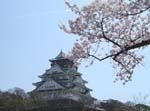
Osaka-jho
 Firearms had been introduced to Japan in -1543 and Oda Nobunaga's great merit was Firearms had been introduced to Japan in -1543 and Oda Nobunaga's great merit was
 that he was able to make effective use of such weapons to maintain his supremacy. He was on the verge of complete reunification of the nation When he was assassinated by one of his generals in 1582. Another general, Toyotomi Hideyoshi, took vengeance on the assassin and succeeded his former master, completing the reunification process. Toyotomi was the son of a farmer who rose through the ranks and was just beginning to prove himself an able leader when he suddenly died whilst supervising an invasion force heading for Korea. Initially he was succeeded by his son, but Tokugawa Ieyasu, a commissioner of the Toyotomi government, mounted a challenge, resulting in the battle of Sekigahara, a town some way east of Kyoto, in 1600. The victor was Tokugawa and the reunification of Japan became a fact Under his administration. A Japanese saying is that, 'Nobunaga made the pie and Hideyoshi baked it, but Ieyasu was the man who ate it.' that he was able to make effective use of such weapons to maintain his supremacy. He was on the verge of complete reunification of the nation When he was assassinated by one of his generals in 1582. Another general, Toyotomi Hideyoshi, took vengeance on the assassin and succeeded his former master, completing the reunification process. Toyotomi was the son of a farmer who rose through the ranks and was just beginning to prove himself an able leader when he suddenly died whilst supervising an invasion force heading for Korea. Initially he was succeeded by his son, but Tokugawa Ieyasu, a commissioner of the Toyotomi government, mounted a challenge, resulting in the battle of Sekigahara, a town some way east of Kyoto, in 1600. The victor was Tokugawa and the reunification of Japan became a fact Under his administration. A Japanese saying is that, 'Nobunaga made the pie and Hideyoshi baked it, but Ieyasu was the man who ate it.'
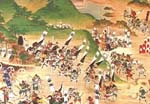
Sekigahara
|
Edo Era (1603 - 1867)
Tokugawa Ieyasu, possibly the most famous man in Japanese history, was appointed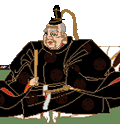 shogun in 1603. He immediately moved the administrative government to Edo (Tokyo), leaving the Emperor and his court in Kyoto without power. The Tokugawa shogunate proved to be the longest warrior class government in Japanese history, lasting for some 260 years. shogun in 1603. He immediately moved the administrative government to Edo (Tokyo), leaving the Emperor and his court in Kyoto without power. The Tokugawa shogunate proved to be the longest warrior class government in Japanese history, lasting for some 260 years.
This became known as the Edo Era. The stability of this period of history resulted from various decisions made by Tokugawa Ieyasu himself, He organized his government very efficiently and used able advisors in various fields, amongst them an Englishman, William Adams, who had been shipwrecked here, as naval advisor. He also became aware of the threat posed by Jesuit Christianity, introduced by St. Francis Xavier in 1549, which was becoming well established in Kyushu and seemed likely to threaten the established feudal system. He was later proven right, for in 1637 there was a rebellion in Nagasaki which had to be crushed by Ieyasu's grandson, Iemitsu. Strict division of governmental powers was introduced. The Tokugawa family took control of major cities, ports and mines, while 270 daimyo were each given their own territory, scattered throughout Japan so as to ensure political security.
Society was clearly divided into four classes. The warriors (shi) were at the top. Next came the farmers (no), then the artisans (ko) and finally the merchants (sho).
To ensure security, the shogun insisted that each daimyo pay a visit to Edo once every two years and that the daimyo's wives and children remain in the city permanently. There they were virtually hostages to ensure the good behavior of the daimyo themselves. Moreover, the arrangement put a severe economic burden on the daimyo, so that they could never consider rebellion and remained loyal to the Tokugawa government at all times. Believing that foreign influences, and Christianity in particular, would have a destabilizing effect on society, the third Tokugawa shogun, Iemitsu, decided to close the country completely, except for a single trade route with the Dutch and Chinese through 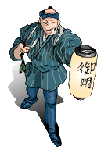 the small island of Dejima in Nagasaki. This seclusion policy lasted for 220 years, starting in 1639. Because of these policies established by his predecessors, the reign of the fifth shogun, Tsunayoshi, saw the peak of political stability and cultural advancement. A series of reforms carried out in 1716 - 1745, followed by others in 1787 - 1793 and 1841 - 1843 resulted in the regaining of much of the prosperity of past ages. the small island of Dejima in Nagasaki. This seclusion policy lasted for 220 years, starting in 1639. Because of these policies established by his predecessors, the reign of the fifth shogun, Tsunayoshi, saw the peak of political stability and cultural advancement. A series of reforms carried out in 1716 - 1745, followed by others in 1787 - 1793 and 1841 - 1843 resulted in the regaining of much of the prosperity of past ages.
All of this pattern of government was disturbed when, in 1853, during the administration of the fourteenth Tokugawa shogun, Commodore Perry of the U.S. Navy came to Uraga, near the present U.S. Navy base at Yokosuka, not far west of Tokyo, bearing a letter from the president of the United States demanding that Japan open its ports to foreign trade. Since for centuries no foreign warships had been seen in Japan, great consternation was caused by the arrival of the four ' Black Ships. The Japanese government promised to give a response the fallowing year and Perry withdrew. He returned the next year with seven ships to assist him in giving a strong hint to the Japanese government. In 1858 the Chief Minister,Naosuke Ii, without consultation with the Emperor and without obtaining a consensus from the influential daimyo, signed a treaty of amity and commerce and opened a limited number Of ports to foreign trade. Because of his dictatorial attitude, Ii was assassinated shortly afterwards. However, the centuries of isolation had been brought to an end. Society was in turmoil because of opposition to the change in policy and it became evident that the days of the Tokugawa shogunate were numbered. 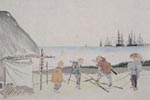 Kurofune |
Meiji Era(1868-1911)
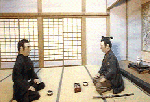 Edo-jo Castle no blood surrender
Edo-jo Castle no blood surrender
 extreme western Honshu) forced the fifteenth Tokugawa shogun, Yoshinobu, to step down from his extreme western Honshu) forced the fifteenth Tokugawa shogun, Yoshinobu, to step down from his  position. The Emperor Meiji took control and proceeded, over the years of his reign, to carry out a series of enlightened reforms@Which established Japan as a modern nation and one to reckoned with. position. The Emperor Meiji took control and proceeded, over the years of his reign, to carry out a series of enlightened reforms@Which established Japan as a modern nation and one to reckoned with.
In 1868, the Emperor transferred the Imperial Palace from Kyoto to Tokyo (as he renamed the city of Edo) and established a strong government led by himself with the assistance of many able advisors. That this, the 'Meiji Restoration', was achieved without bloodshed is a great tribute to the wisdom of the leaders of both sides. The Emperor restored the lands of the provincial feudal lords and appointed them governors of their prefectures. He replaced Buddhism with Shintoism as the state religion, the latter regarding him as a living god, under whom four new classes of citizens were established, these being the Emperor's family and relatives (kozoku), the ex-daimyo (kazoku), the ex-Warriors (shizoku) and the ordinary people (heimin). However, the Emperor's hold on power was still tenuous and there was always the threat of revolt until 1877 when Saigo Takamori,who had left the government as a result of disagreements over foreign policy, reluctantly led a major rebellion by ex-samurai in the south of Kyushu. He was defeated in Kumamoto where he attempted to besiege government troops in the castle, and retreated to Kagoshima,where he killed himself in a cave after an unsuccessful rearguard action. The Emperor restored the lands of the provincial feudal lords and appointed them governors of their prefectures. He replaced Buddhism with Shintoism as the state religion, the latter regarding him as a living god, under whom four new classes of citizens were established, these being the Emperor's family and relatives (kozoku), the ex-daimyo (kazoku), the ex-Warriors (shizoku) and the ordinary people (heimin). However, the Emperor's hold on power was still tenuous and there was always the threat of revolt until 1877 when Saigo Takamori,who had left the government as a result of disagreements over foreign policy, reluctantly led a major rebellion by ex-samurai in the south of Kyushu. He was defeated in Kumamoto where he attempted to besiege government troops in the castle, and retreated to Kagoshima,where he killed himself in a cave after an unsuccessful rearguard action. 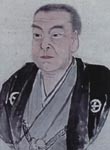
The Emperor was intent upon the advancement of the Country. He developed heavy industries, including steel, mining and cotton. He established an army based upon the German model and a navy based upon the British one. Telephones were introduced in 1869 and the first railway was opened between Shinbashi in Tokyo and the port of Yokohama in 1872. In the same year, a compulsory education system was introduced, enabling all citizens to receive
six years of basic primary education. A western-style constitution was introduced in 1889. To assist with these reforms, a group of foreign advisors was invited to Japan and scholars were sent abroad to study.
The confidence derived from the establishment of strong military forces, in combination with diplomatic recognition, led to an upsurge in nationalism and militarism, both of which were further stimulated by successes in the Sino-Japan War of 1894-and the Russo-Japan War of 1904. Having demonstrated its new-found strength, the military demanded an increased role in domestic politics, a dangerous precedent to establish.
The Emperor Meiji died in 1912, but an impressive legacy remained. More than any other Emperor in Japanese history, he had left his mark upon the nation and was to be remembered and revered by his people as none of his predecessors ever had been.
|
Taisho Era (1912 - 1926)
Although the Emperor Taisho was weak both physically and mentally, he was supported
by able ministers and his reign passed without any major difficulties arising. In 1914, the First
World War started and Japan supported the Allies, which resulted in various economic
benefits and a general international acceptance of the country. Following the war, in 1920
Japan joined the League of Nations.
The greatest set-back to the country during this period was a natural disaster, for in 1923
the Great Kanto Earthquake occurred, killing 100,000 people in and around Tokyo.
|
Showa Era (1926 - 1989)
On Christmas Day 1926 the Emperor Showa came to power. The choice of the name
Showa ('Brilliantly Peaceful') for his reign was to prove unfortunate, for it turned out to be
neither brilliant nor peaceful.
The Great Depression started in the U.S.A. in 1929 and spread throughout the world,
affecting Japan just as it did all other industrialized nations. Partly to divert attention from
these problems, the military leaders developed the Far East Co-Prosperity Scheme, a thinly
veiled attempt at imperialistic expansion. Within Japan a propaganda campaign was trying to
convince the population that the nation was the chosen vanguard to lead Asia on the path to
success. A feeling of extreme nationalism pervaded the atmosphere and the military gained in
power. In 1931, Manchuria was invaded and a puppet regime installed. The League of Nations
demanded Japan's withdrawal from the province, but instead, in 1933, Japan chose to leave
the League of Nations. The military became audacious enough to engineer the assassination of
the prime minister in 1932 and of other top ministers in 1936.
By 1937, Japan was at war with China and in 1939 the Second World War started.
Japan's excursions into Asia brought about severe conflicts of interest with other nations and
finally, in 1941, the nation committed the ultimate folly of attacking the U.S. navy at Pearl
Harbor, thereby committing itself to a major war which it had little chance of winning.
1,860,000 military personnel were lost and there were 670,000 civilian casualties by the time
that Japan surrendered unconditionally in 1945 following the atomic bombing of Hiroshima
and Nagasaki. It was the first time in its history that the country had been occupied by a
foreign force.
 Following this defeat, Japan was rebuilt and restructured under the American Following this defeat, Japan was rebuilt and restructured under the American
occupation. The governmental, economic, social and educational systems were completely
revised. In 1946, a new constitution was promulgated, declaring that the three basic principles
of the country were national sovereignty, the granting of basic human rights and the
renunciation of war. In 1947, an education system was adopted giving six years of primary
education, three years of lower secondary education, a further three years of upper secondary
education and four years of tertiary education. In 1951, at San Francisco, Japan concluded
peace treaties with 48 nations, not, however, including the U.S.S.R., which held, as Russia
now continues to hold, certain islands off the east coast of Hokkaido which had always been
regarded as Japanese territory.
Japan's determined efforts to rebuild its economy have brought the nation a new wave
of prosperity. The speed of this recovery has surprised the whole world and can be attributed
principally to five factors: firstly to the hard-working ethics of the Japanese character;
secondly to the high levels of education and technical skills; thirdly to the concerted effort to
rebuild, by pouring most of the nation's capital into industrial reconstruction and development;
fourthly to the policy of total disarmament and the surrender of colonial territories, which
released the country from a huge burden of expenditure; and fifthly to the unique management
system offering, amongst other benefits, secure lifetime employment.
Economically, Japan has become one of the world's major powers. In 1954, the
Japanese government felt in a position to start offering overseas aid and, by the close of the
Showa Era, the country had become the world's second largest donor, providing about eight
billion dollars annually to 25 countries.
Towards the end of 1988, the Emperor Showa became ill, with his condition
deteriorating day by day. He died in the first week of 1989 and his son succeeded him,
becoming Japan's 125th Emperor. The Showa Era had lasted for 62 years and two weeks, by
far the longest reign in Japanese history.
|
Heisei Era (1989 - )
The new Emperor chose to call his reign the Heisei Era, meaning the 'Era of Spreading
Peace'. He brings to the throne a rather different background from that of past Emperors, for
he undertook post-graduate education in England and is the first Emperor to be married to a
commoner.
The economic miracles of Japan have continued into his reign, but the 'Bubble
Economy' of the end of the Showa Era eventually burst and this resulted in a recession minor
by world standards, but, nevertheless, a shock to Japan, which had become accustomed to an
unrelieved diet of success.
Politically, too, changes have come recently. For 38 years until 1993, the government
had been formed by members of the Liberal Democratic Party, the only matter in dispute being
which faction of the party would, hold control at any particular time. However, a series of
political scandals disenchanted voters, starting with the Lockheed bribes involving the prime
minister of the time, Mr.Tanaka, and continuing with the Recruit Cosmos scandal, involving
the sales to politicians of shares certain to rise very rapidly in value, and the Sagawa Delivery
Service payments made to various politicians in high, positions. In 1993, the Liberal
Democratic Party failed to win a majority in the general election and was replaced by a
coalition of opposition parties. However, this has proven to be a fragile coalition unable to
enact any controversial legislation; due to the necessity of appeasing the views of various
members with different backgrounds. Nevertheless, it has shattered the myth that the Liberal
Democratic Party is invincible.
The recent recession and the steady rise in the value of the yen have certainly made
economic conditions less favourable for Japan, but the nation's, response has been to
rationalize and economize where possible, and there was plenty of scope for such measures, so
that products still remain of high quality and competitive in price and, for a while at least, the
prosperity of the nation seems assured. |
|
Written by T.Kusunoki
From (introductory part of book) "Japan"
Published by Borgnan Corporation
Copyright(C)2004-2005 Borgnan Co.,Ltd. All Rights Reserved.
|
|